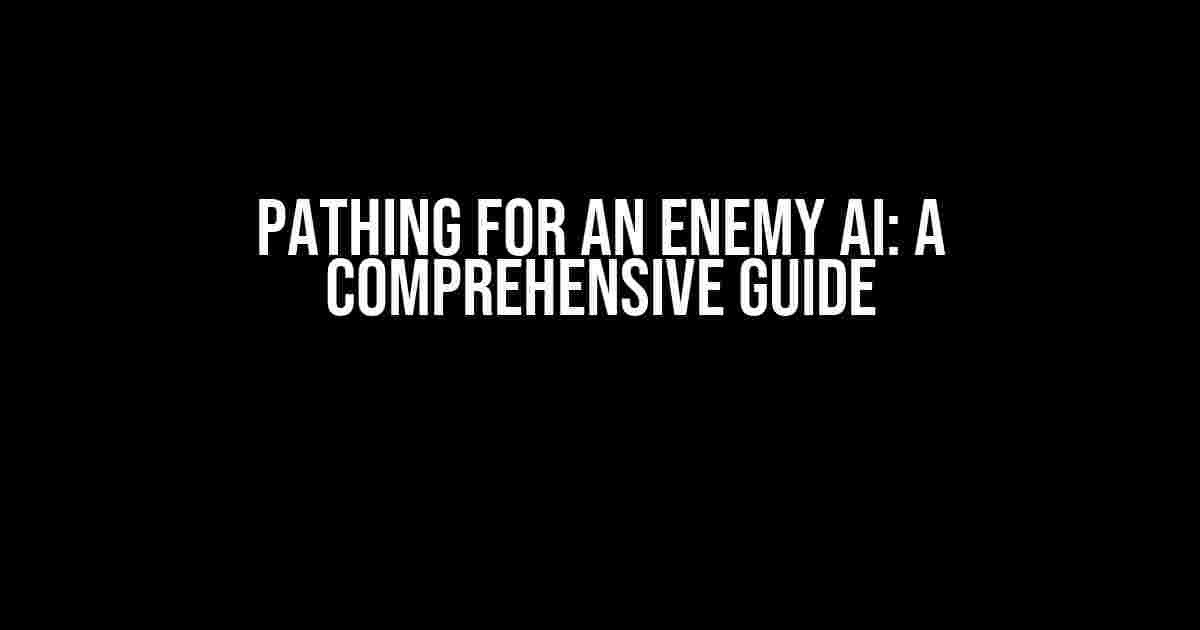Ah, the eternal quest for AI domination! As a game developer, you know that creating an enemy AI that’s both challenging and intelligent is a crucial aspect of building an engaging game. But, let’s face it, pathfinding can be a real nightmare. Fear not, dear reader, for today we’ll embark on a thrilling adventure to conquer the realm of pathing for an enemy AI. Buckle up, and let’s get started!
What is Pathfinding, Anyway?
Pathfinding is the process of finding the most efficient route between two points in a game world. Sounds simple, right? Well, it’s not. In the context of an enemy AI, pathfinding is the ability to navigate through the game environment, avoiding obstacles, and reaching the player (or other targets). The goal is to create an AI that can adapt to changing circumstances, making it a formidable opponent.
Types of Pathfinding Algorithms
There are several pathfinding algorithms to choose from, each with its strengths and weaknesses. Here are some of the most popular ones:
- Dijkstra’s Algorithm: A classic algorithm that finds the shortest path between two points by assigning a cost to each node in the graph.
- A\* Algorithm: An optimization of Dijkstra’s algorithm that uses heuristics to focus on the most promising areas of the graph.
- Floyd-Warshall Algorithm: An algorithm that finds the shortest path between all pairs of nodes in a weighted graph.
- Navigate Mesh: A navigation mesh is a data structure that represents the game world as a set of interconnected nodes.
Setting Up the Scene
Before we dive into the implementation details, let’s set up a simple scene to demonstrate the concepts. Imagine a 2D platformer where the enemy AI needs to navigate through a maze to reach the player.
// Game world representation
+---------------+
| |
| Player |
| |
+---------------+
| |
| Obstacles |
| |
+---------------+
| |
| Enemy AI |
| |
+---------------+
Coding the Enemy AI
For this example, we’ll use a simple A\* algorithm implementation in C#:
public class EnemyAI {
public Vector2 position;
public Vector2 targetPosition;
private NavMesh navMesh;
public EnemyAI(NavMesh navMesh) {
this.navMesh = navMesh;
}
public void Update() {
// Calculate the path to the target position
List<Vector2> path = CalculatePath(position, targetPosition);
// Move towards the next node in the path
MoveTo(path[0]);
}
private List<Vector2> CalculatePath(Vector2 startPosition, Vector2 targetPosition) {
// Create a priority queue to hold the nodes to be processed
PriorityQueue<Node> queue = new PriorityQueue<Node>();
// Add the starting node to the queue
queue.Enqueue(new Node(startPosition, 0));
// Create a dictionary to store the node costs
Dictionary<Vector2, float> nodeCosts = new Dictionary<Vector2, float>();
// Loop until the target node is reached or the queue is empty
while (queue.Count > 0) {
Node currentNode = queue.Dequeue();
// If the current node is the target node, return the path
if (currentNode.position == targetPosition) {
return BuildPath(currentNode);
}
// Mark the current node as processed
nodeCosts[currentNode.position] = currentNode.cost;
// Add neighbors to the queue
foreach (Node neighbor in GetNeighbors(currentNode.position)) {
if (!nodeCosts.ContainsKey(neighbor.position)) {
float cost = currentNode.cost + CalculateHeuristic(neighbor.position, targetPosition);
queue.Enqueue(new Node(neighbor.position, cost));
}
}
}
// If the target node is not reachable, return an empty list
return new List<Vector2>();
}
private List<Vector2> BuildPath(Node node) {
List<Vector2> path = new List<Vector2>();
while (node != null) {
path.Add(node.position);
node = node.parent;
}
return path.Reverse();
}
private Node GetNeighbors(Vector2 position) {
// Return a list of neighboring nodes
}
private float CalculateHeuristic(Vector2 position, Vector2 targetPosition) {
// Return the heuristic cost between the two positions
}
}
Navigating the Mesh
In the previous example, we used a simple A\* algorithm to find the shortest path to the target position. However, this approach has some limitations. What if the game world is complex, with multiple levels, obstacles, and hidden areas? That’s where navigation meshes come into play.
A navigation mesh is a data structure that represents the game world as a set of interconnected nodes. Each node represents a navigable area, and the edges between nodes define the connections between these areas.
// Navigation mesh representation
+---------------+
| |
| Node 1 |
| (x1, y1) |
+---------------+
| |
| Node 2 |
| (x2, y2) |
+---------------+
| |
| Node 3 |
| (x3, y3) |
+---------------+
| |
| ... |
| |
+---------------+
By using a navigation mesh, we can efficiently query the game world for navigable paths, taking into account obstacles, level boundaries, and other constraints.
Querying the Navigation Mesh
To use the navigation mesh, we need to query it to find the shortest path between two nodes. This can be done using a variant of Dijkstra’s algorithm, optimized for navigation meshes:
public class NavMesh {
private Dictionary<Vector2, Node> nodes;
public NavMesh(Dictionary<Vector2, Node> nodes) {
this.nodes = nodes;
}
public List<Vector2> FindPath(Vector2 startPosition, Vector2 targetPosition) {
Node startNode = nodes[startPosition];
Node targetNode = nodes[targetPosition];
// Create a priority queue to hold the nodes to be processed
PriorityQueue<Node> queue = new PriorityQueue<Node>();
// Add the starting node to the queue
queue.Enqueue(startNode);
// Create a dictionary to store the node costs
Dictionary<Node, float> nodeCosts = new Dictionary<Node, float>();
// Loop until the target node is reached or the queue is empty
while (queue.Count > 0) {
Node currentNode = queue.Dequeue();
// If the current node is the target node, return the path
if (currentNode == targetNode) {
return BuildPath(currentNode);
}
// Mark the current node as processed
nodeCosts[currentNode] = currentNode.cost;
// Add neighbors to the queue
foreach (Node neighbor in currentNode.GetNeighbors()) {
if (!nodeCosts.ContainsKey(neighbor)) {
float cost = currentNode.cost + CalculateHeuristic(neighbor.position, targetNode.position);
queue.Enqueue(neighbor);
}
}
}
// If the target node is not reachable, return an empty list
return new List<Vector2>();
}
private List<Vector2> BuildPath(Node node) {
List<Vector2> path = new List<Vector2>();
while (node != null) {
path.Add(node.position);
node = node.parent;
}
return path.Reverse();
}
private float CalculateHeuristic(Vector2 position, Vector2 targetPosition) {
// Return the heuristic cost between the two positions
}
}
Conclusion
Pathing for an enemy AI can be a daunting task, but by breaking it down into smaller components and using the right algorithms and data structures, we can create a more efficient and effective AI. Remember, the key to a great AI is to balance complexity with performance, ensuring that your game runs smoothly while still providing a challenging opponent.
In this article, we covered the basics of pathfinding, setting up a simple scene, coding the enemy AI using A\* algorithm, and navigating a navigation mesh. By following these steps, you’ll be well on your way to creating an intelligent and formidable enemy AI.
Happy coding, and may the path be with you!
| Pathfinding Algorithms Comparison | |
|---|---|
| Algorithm | Description |
| Dijkstra’s Algorithm | Finds the shortest path between two points by assigning a cost to each node in the graph. |




